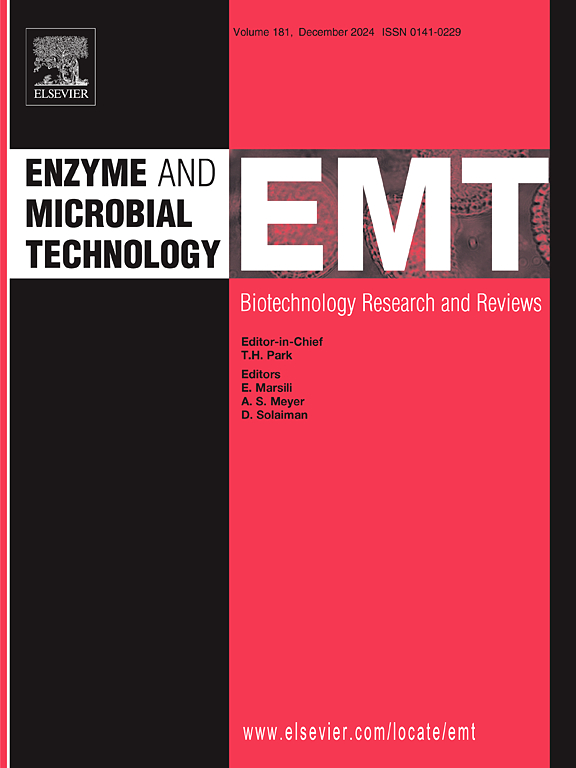产1,8-桉叶油素的脂性耶氏菌基因工程:可持续途径
IF 3.7
3区 生物学
Q2 BIOTECHNOLOGY & APPLIED MICROBIOLOGY
引用次数: 0
摘要
1,8-蒎烯是一种具有多种工业和医药用途的单萜烯,因其独特的性质而备受关注。本研究旨在通过代谢和培养基工程策略,从脂肪分解亚罗酵母中实现 1,8-松油的可持续生产。研究人员通过 CRISPR-Cas9 技术整合了来自克拉维氏链霉菌的异源 1,8-蒎烯合成酶,同时过度表达了甲羟戊酸途径中的关键基因,并对 Erg20p 进行了双突变,以提高其对焦磷酸香叶酯的通量。对改造后的菌株进行了进一步研究,以确定在加入 MgSO4 后碳源和氮源的变化情况。在 5 % WCO 的条件下,上述方法使 1,8-松油的滴度达到了 4.68 mg/L,细胞内角鲨烯的滴度达到了 1108.53 mg/L,这是首次报道脂溶性酵母菌通过基因工程生产 1,8-松油。为提高产量和生产率,目前正在开展进一步研究,以将内部通量转向 1,8-松油。这项工作展示了一种可持续的、创新的生物技术方法,可改善萜烯的生物合成和废物的价值化。本文章由计算机程序翻译,如有差异,请以英文原文为准。
Genetic Engineering of Yarrowia lipolytica for 1,8-cineole production: A sustainable approach
1,8-Cineole, a monoterpene with diverse industrial and pharmaceutical applications, has garnered significant interest due to its unique properties. This study aims to achieve sustainable production of 1,8-cineole from Yarrowia lipolytica through metabolic and media engineering strategies. The heterologous 1,8-cineole synthase from Streptomyces clavuligerus was integrated through CRISPR-Cas9, along with overexpression of key genes in the mevalonate pathway and a double mutation in the Erg20p to enhance flux towards geranyl pyrophosphate. The modified strain was further investigated for varying carbon and nitrogen sources with MgSO4 addition. The above approaches achieved a titer of 4.68 mg/L of 1,8-cineole along with 1108.53 mg/L of intracellular squalene when grown on 5 % WCO, marking the first report of genetic engineering of Y. lipolytica for 1,8-cineole production. Further studies are in progress to redirect internal fluxes to 1,8-cineole for improvising yields and productivities. This work shows a sustainable and innovative approach to biotechnology improvements in terpene biosynthesis and waste valorization.
求助全文
通过发布文献求助,成功后即可免费获取论文全文。
去求助
来源期刊

Enzyme and Microbial Technology
生物-生物工程与应用微生物
CiteScore
7.60
自引率
5.90%
发文量
142
审稿时长
38 days
期刊介绍:
Enzyme and Microbial Technology is an international, peer-reviewed journal publishing original research and reviews, of biotechnological significance and novelty, on basic and applied aspects of the science and technology of processes involving the use of enzymes, micro-organisms, animal cells and plant cells.
We especially encourage submissions on:
Biocatalysis and the use of Directed Evolution in Synthetic Biology and Biotechnology
Biotechnological Production of New Bioactive Molecules, Biomaterials, Biopharmaceuticals, and Biofuels
New Imaging Techniques and Biosensors, especially as applicable to Healthcare and Systems Biology
New Biotechnological Approaches in Genomics, Proteomics and Metabolomics
Metabolic Engineering, Biomolecular Engineering and Nanobiotechnology
Manuscripts which report isolation, purification, immobilization or utilization of organisms or enzymes which are already well-described in the literature are not suitable for publication in EMT, unless their primary purpose is to report significant new findings or approaches which are of broad biotechnological importance. Similarly, manuscripts which report optimization studies on well-established processes are inappropriate. EMT does not accept papers dealing with mathematical modeling unless they report significant, new experimental data.
 求助内容:
求助内容: 应助结果提醒方式:
应助结果提醒方式:


